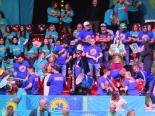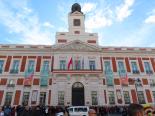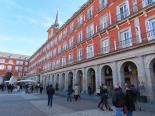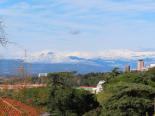Profile
Blog
Photos
Videos
...may well be on the plain, but today was also in the city. Nevertheless I jumped on to the Metro Line 3, disembarking at Callao, where I emerged into the Plaza del Callao. This had a slightly more modern feel than the other plazas I've encountered so far, probably due to the digital advertising hoardings.
I then wandered along to the Museo de Historia de Madrid. I spent a fascinating 2-3 hours in this free museum, reading about the history of Madrid, where all the information panels were in both Spanish and English. It detailed how Madrid was transformed from a small settlement into a major city once the royal court was established there.
Leaving the museum it was time for a spot of lunch. Fortunately just up the road was SteakBurger. Proclaiming to be The House of Premium Beef, I popped in and decided to sample their Melting Cheese Burger - stuffed with Cheddar Cheese, Gouda and Mozzarella, and topped with Provolone Cheese. Wow, the 250g burger was beautifully cooked and very tasty, with lovely fries. It was accompanied with Coke Zero and I followed it up with a black coffee.
Fully sated, I continued my wandering in the direction of Palacio Longoria. This stunning example of Art Nouveau architecture was created for banker Javier Gonzalez Longoria in 1902. Restored in the 1990s, it is now home to the Spanish Society of Authors and Publishers, and not open to the public.
Next my feet led me to the Iglesia de Santa Barbara. The monastery of the Royal Salesians was founded by Barbara de Braganza, wife of Ferdinand VI. Worried what her disapproving and overbearing mother-in-law might do if her husband died first, Barbara wanted to ensure she had a refuge into which she could escape if necessary. Infact, she pegged it first. The remaining 1750 Baroque church is only open for services.
Behind the church is the Palacio de Justica, looking out over the Plaza Villa de Paris. Built in the 1750s as the convent of the Royal Salesians, it was converted into the Palace of Justice in the 1870s, and had to be restored following a fire in 1915. The Plaza Villa de Paris was originally the garden and orchard of the convent. The two statues are appropriately of King Ferdinand VI and Barbara de Braganza.
By this time I had left the hustle and bustle behind and wandered quite streets to the Plaza del Ray and the Casa de las Siete Chimeneas. Built around 1570, The House of The Seven Chimneys is one of the finest surviving examples of the architecture of the time. Said to be haunted by a lover of Felipe II, a female skeleton was discovered at the end of the 19th century. The house, not open to the public, was once owned by the Marques de Esquilache, the Chief Minister to Carlos III. The Marques' attempts to outlaw the traditional gentleman's cape and broad-brimmed hat, on the grounds that rogues used one to hide weapons and the other to conceal their faces, is said to be one of the factors that led to the 1766 riots!
Moving on I rejoined the crowds in the Calle de Alaca, with its imposing grand buildings including the Edificio Metropolis (1905) and Banco de Espana (1856). Making my way along the street towards the Plaza de Cibeles, there were a lot of police around, the reason for which became evident later.
The Plaza is one of Madrid's busiest traffic intersections but is also home to one of the city's most famous landmarks - the Fuente de Cibeles (Cibeles Fountain). Created by Spanish architect Ventura Rodriguez between 1777 and 1782, the fountain depicts the goddess of nature and abundance (Cibeles) riding her chariot pulled by two prancing lions. The cherubs sprouting water are a later addition, at the end of the 19th century.
Surrounding the Plaza are a number of impressive buildings. The aforementioned Banco de Espana is joined by the Casa de America (formerly Linares Palace, constructed 1877-1900) and the over-the-top Palacio de Comunicaciones, built 1907-19 and previously known as the Palacio de Cibeles.
A little further up Calle de Alcala is the Plaza de la Independecia, in the centre of which is the Puerto de Alcala. Designed by Francisco Sabatini, the Neo-Classical city gateway was built in 1769.
Off the Plaza is an entrance to Madrid's popular large park, the Parque del Retiro. Hoping to explore that on a sunnier day, I walked down the Calle de Alfonso XII alongside the park and then past the Museo del Prado, one of the world's finest art galleries. As it was starting to rain it may well have been an opportune moment to pop in, if it wasn't for the long queue.
So I headed back up to the Banco de Espana to jump on the Metro when the reason for the large police presence became clear, a large demonstration. I couldn't make out what it was about, so popped into the Metro station to make my back to Legazpi. Later research revealed it was an anti-racism demonstration, so very worthwhile and sadly still necessary.
- comments










